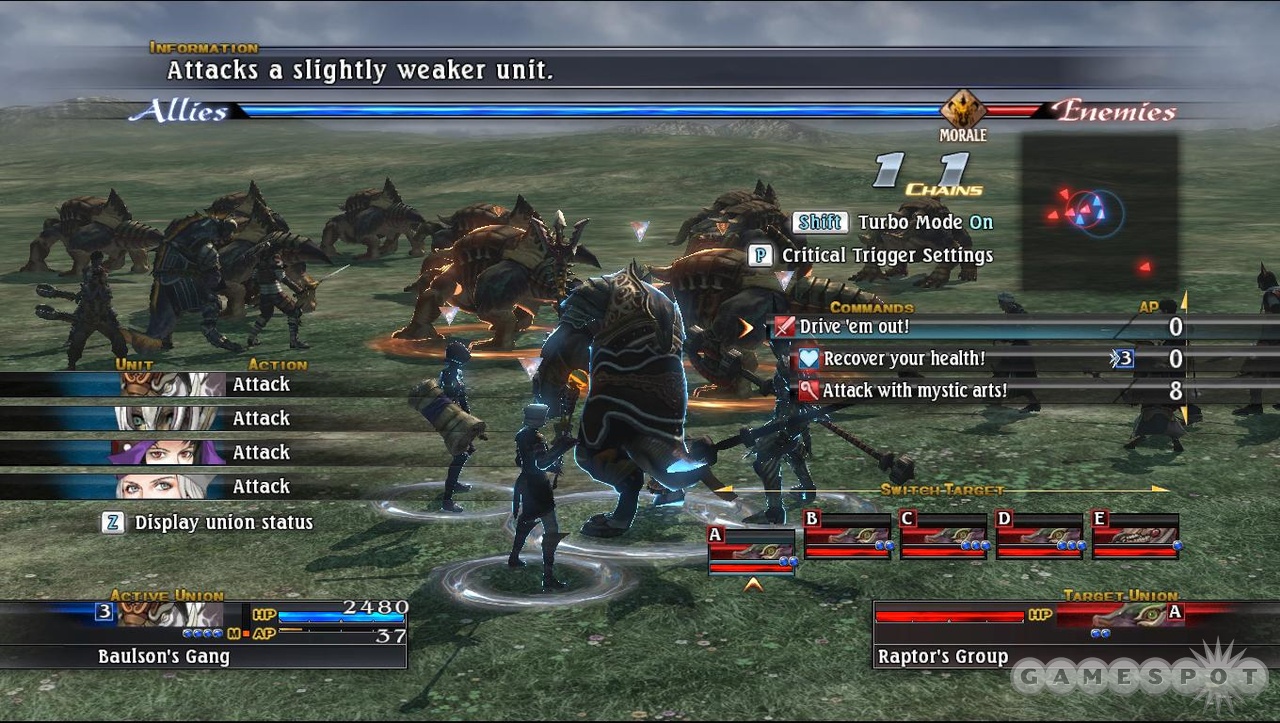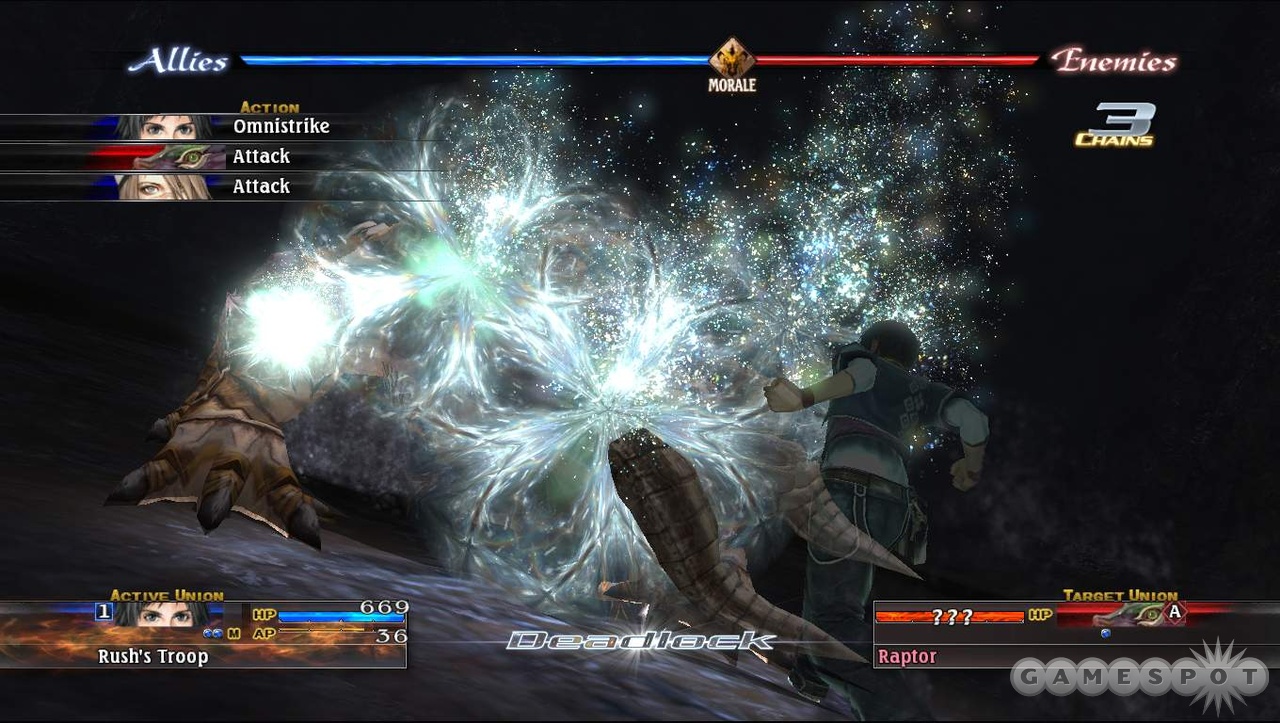The PC has not provided a home to many Japanese role-playing games, and when it has, the results have been uneven. How refreshing, then, that The Last Remnant is such an entertaining experience. It features a rich, original fantasy world, obviously crafted with great care and artistry, and it tells a strong, politically charged tale that will keep you glued to the screen. Although somewhat flawed, the battle system is fun to play around with, particularly in the second half when enormous armies go head to head in some dramatic, bloody showdowns. When the game was released on the Xbox 360 in 2008, these elements were partially buried under an avalanche of shameful technical problems. But with nary a hint of slowdown and less noticeable texture pop-in, The Last Remnant's excellent gameplay shines on the PC, making it a journey that almost any RPG fan should take.
Rush Sykes is the prototypical fantasy hero, innocently sulky but totally devoted to his sweet sister Irina. When Irina is kidnapped, Rush hurries to liberate her, but unsurprisingly, it's not the most straightforward of rescues. Rather, Rush finds himself caught in a political struggle centered around powerful magical artifacts called remnants. These objects are both the center of society as well as a great curiosity, heavily researched at the Academy by hosts of scientists, including Rush's own parents. What starts as an upheaval between the pro- and anti-remnant factions explodes into an all-out war when a formidable hulk of a man calling himself the Conqueror appears, apparently able to control any remnant, no matter how large or potent. Political forces clash and hidden powers are unleashed, and though a tenuous peace is eventually achieved, it isn't long before conflict reawakens. The story is epic, though Rush himself isn't the most interesting leading man. Fortunately, his supporting cast is excellent; the noble David is a charmingly haughty presence, and David's guard Emma makes a strong impression, thanks to some excellent, emphatic voice acting.
Whereas other RPGs tend to center on their protagonist, The Last Remnant eventually focuses on the Conqueror and his secrets. He's a solemn, momentous presence who makes an impact each time he appears, and it's easy to believe that this man may actually be capable of controlling the universe. But though it will take you a good 60 hours or more to unravel all of his secrets, the journey is entertaining, given that The Last Remnant's distinctive fantasy world is so beautifully constructed. Each city you visit is different from the last, yet the overall vision is cohesive, so nothing feels out of place. Landmarks such as the towering, glowing remnant in Elysion are not soon forgotten, and numerous side quests will have you exploring scorching deserts, caves of bubbling lava, and even the land of the dead. Most of these locales are lovely and beautifully lit.
Those attractive environments were squandered on the Xbox 360, on which awful technical problems soiled the artistic beauty. On the PC, the frame rate remains smooth, which makes it easy to drink in the scenery and fully enjoy the bloody drama of The Last Remnant's spectacular-looking battles. Texture pop-in, a telltale sign of the Unreal 3 Engine, is still present but less conspicuous, and the loading times have been markedly improved, which keeps the pace flowing nicely. However, a new problem has cropped up in the form of some occasional screen tearing, and the lack of an in-game v-sync option means that you'll need to adjust the settings in your video-card software if it gets bothersome. Nevertheless, these issues are relatively minor, and though some low-resolution textures and simple geometry may occasionally distract PC enthusiasts with keen eyes, the game's technical aspects ably support its art design.

The Last Remnant's battle system is intriguing, though you will be several hours in before you can appreciate its intricacies. Rather than controlling party members during combat, you recruit leaders and soldiers, and group them together into unions. Although each unit has his or her own stats, equipment, and arts (the game's versions of spells and combat skills), you issue union-wide, turn-based commands on the field. Whereas in most RPGs you choose very specific actions, such as casting a particular spell or using a particular item, in The Last Remnant you choose broader commands. These may include healing unions that need it; performing mystic arts (though you can see which arts the units will use, you can't micromanage them on a unit-by-unit basis); or summoning Rush's awe-inspiring, beautifully designed cyclops to assist in battle.
Early in the game, when you don't have a whole lot of unions under your command, you may bemoan the lack of micromanagement that this system entails. The fundamentals are a little confusing too, given that there doesn't always seem to be rhyme or reason to the process that decides which abilities are available to you and when. Later on, however, you'll have a lot more units under your command, and you'll discover how elaborate battles can become. As units use certain arts, they level up those arts and learn newer ones, all the while improving stats--though it's unclear how some of those stats affect the outcome of your actions. (Units possess such attributes as gluttony; what does that do, anyway?) Thus, grouping units into sensible unions is crucial, as is grouping them into an appropriate formation. You can get through many standard battles without putting too much thought into these aspects, if you take a lot of side quests and grind your way to power. However, even with a bit of grinding, the biggest battles require care, both before and during combat. As you play, you'll gain a better grasp of your enemies' weaknesses, the pros and cons of each formation, and the best way to develop your individual units through battle commands.
Eventually, you'll experience some large, impressive-looking battles. They can also be really challenging, so don't expect to rush to a victory, particularly when dozens of unions are involved. On the PC, limits on the number of leaders you can employ on the battlefield have been removed, but financial restrictions and more resilient enemies prevent battles from getting too easy. Individual turns can take a while to complete, but by repairing the frame rate issues that plagued the Xbox 360 version, developer Square Enix has also accelerated the pace of battle. The game will also throw quick-time events called critical triggers at you that require a rapid button or key press; performing it correctly may initiate a counterattack, or will improve your units' position in the turn order. These events, like most of the game, are best experienced with a gamepad in hand. We were able to play successfully with several different gamepads, including an Xbox 360 pad. The keyboard is supported, of course, and that scheme is perfectly functional, if less natural than the alternative. Thankfully, if you aren't a fan of quick-time events, there is an option to have critical triggers resolved automatically.

The colossal battles are the highlight of the game, not just because they are impressively dramatic, but also because you can see the effects of your union makeup, formations, and in-battle decisions more clearly than in the smaller ones. A morale bar across the top of the screen adjusts during the constant tug of war, based on whether you are attacking an enemy's flank or rear, which status effects are active, and a number of other factors. Location on the battlefield, attack range, and potency of healing items and arts are among the many other dynamics that you'll need to consider as you plan out your turn. This thoughtful preparation makes it all the more heartbreaking when you lose a long, well-planned battle. A significant number of late-game skirmishes take a long time to complete, often stringing several tough encounters together. Considering that formations and union setup can require a bit of trial and error, you might lose a bit of progress the first few times you attempt these colossal battles. Thankfully, the combat is fun and addictive, and a high-speed battle option new to the PC version also alleviates the frustration. But given the length of these lengthy clashes, it's vexing that you are not allowed to save between turns. Otherwise, you can save almost anywhere, and the ability to skip cutscenes should you need to replay a section is also a welcome convenience.
Outside of combat, a little scavenger named Mr. Diggs will excavate various raw materials that you encounter in dungeons. Along with the monster parts that you forage, these items can be used to upgrade your equipment or create new weapons and accessories. There's not much to the process, and you can customize only Rush's equipment; other units take care of things on their own, using the items you let them keep in the postbattle screen to upgrade their stuff, or asking if you'll take them hunting for a particular resource. Considering that characters develop based on the attacks they perform, there is a lot of flexibility--and intangibility--to party progression. As a result, there is a certain amount of replay value here, if only to see how differently battles can play out if you decide to make Rush concentrate solely on mystic arts, or see what happens when the four-armed Torgal focuses on combat skills.

The Last Remnant sounds mostly spectacular. The voice acting isn't always excellent, though it's hard to fault the actors when they're forced to deliver some of the game's awkward dialogue and odd bits of slang. Everything else is of top quality, particularly the fantastic symphonic soundtrack. Even after hundreds and hundreds of encounters, the battle music is always rousing, and the triumphant fanfare after every conflict rivals the best of the genre. Every town has its own theme music, and the melodies are terrific in their own right and flawlessly match the city's unique visual design as well.
By fixing the frame rate and other technical issues that encumbered the Xbox 360 version, Square Enix has improved the entire experience, allowing the great story and fun gameplay to sparkle on their own terms. Granted, The Last Remnant could have been tightened up even more, but even with its occasional visual and gameplay foibles, it's a delight from beginning to end.